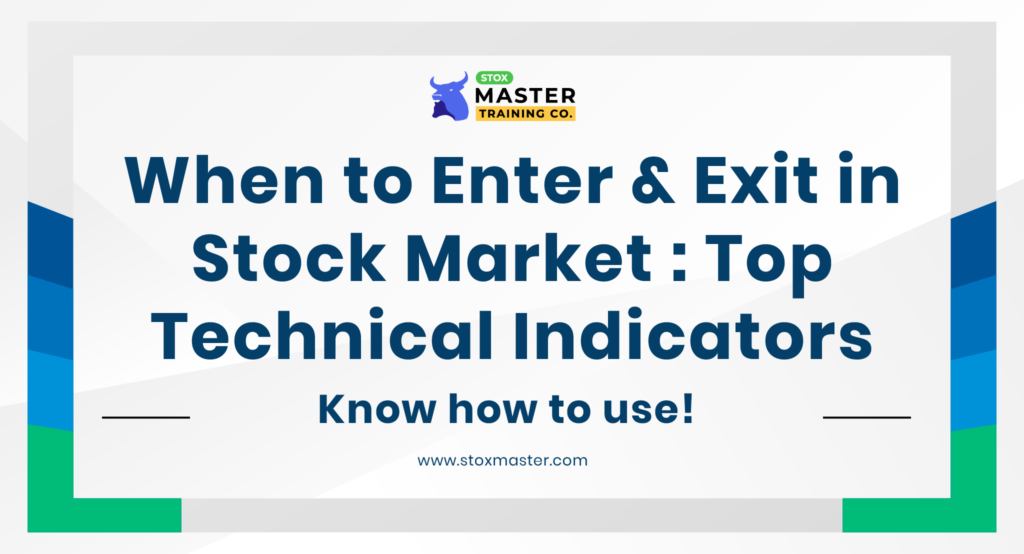
Indicators are like a compass, they give you direction but don’t tell you where to go.
– Linda Raschke
Knowing the right time to enter and exit a market is crucial to achieving success in trading. Whether you are investing in stocks, forex, or any other financial market, identifying entry and exit points is essential for making profitable trades. Fortunately, there are several methods and indicators that traders can use to identify these points.
In this blog, we will discuss the top entry and exit indicators for trading all types of assets. We will also explore the importance of understanding entry and exit points, as well as the various technical indicators used to identify them.
Understanding Entry Points
An entry point is the price level at which an investor or trader enters a market to buy a security. This decision is often based on a well-studied trading strategy that reduces investment risk and eliminates emotional judgment. By conducting thorough analysis and research, investors can make objective investment decisions that increase their chances of success. An investor can typically optimize several entry points after a brief counter-trend relocation or a time frame of consolidation in a stock. Algorithmic trading also allows traders to designate entry points, enabling trades automatically when specific conditions are met.
Understanding Exit Points
An exit point is the price level at which an trader sells their security to realize a profit or cut their losses. The decision to sell is crucial in trading, and traders must have a clear strategy in place to determine the right time to exit a trade. Typically, Traders close their position by selling the asset at the exit point. However, if the trader is short, they may buy at an exit point to close their position.
Best Entry and Exit Point Indicators Technical indicators assist traders in choosing whether to buy or sell a security. They are produced using fundamental arithmetic estimation and help traders identify the ideal entry and exit points. There are dozens of indicators available today, but we will discuss the top indicators used by traders to locate entry and exit points.
Moving Averages – Technical Indicator
Moving averages are among the sluggish technical indicators used by traders to identify the trend’s direction. They are calculated by adding up any economic security data points and dividing the total value of data points over a given period. By assessing the asset’s price changes, an analyst uses the moving average to identify support and resistance areas on candlestick charts. This indicator displays a security’s historical price movement, which traders can use to predict how an asset’s price may move identifying the candlestick chart patterns.
Bollinger Bands – Technical Indicator
Bollinger Bands are a volatility indicator that determines the comparative highs and lows of a security’s price in relation to earlier trades. Variance, which alters with volatility increases or decreases, is used to measure volatility. When prices rise, the bands get wider, and when prices fall, they get narrower. Bollinger Bands can be used to trade various stocks because of their fluid nature.
Stochastic Oscillator – Technical Indicator
The stochastic oscillator is a popular trading tool for predicting trend reversals. It also emphasizes price boost and could be used to spot overvalued and oversold tiers in various investment assets, including shares, index values, exchange rates, and many others. The stochastic oscillator measures the momentum of price changes. The frequency of velocity in price movement is known as acceleration. The stochastic indicator’s premise is that an instrument’s price momentum will frequently change before the instrument’s price movement changes direction. The indicator can, therefore, be used to foretell trend reversals.
Relative Strength Index – Technical Indicator
The relative strength index (RSI) is the most widely used oscillator on the market. Its primary use is to identify overbought and oversold trading levels. The RSI is a technical indicator utilized in the study of financial markets, charting the past and present strengths or weaknesses of a stock or market based only on the close price levels of the latest trading period.
Technical Indicator MACD – The moving Average Convergence Divergence
The moving average convergence divergence (MACD) indicator is created by using moving averages, which are then converted into oscillators. This technical indicator is a tool for locating moving averages that signal a new trend, whether bullish or bearish. Finding a trend is crucial in trading, as that’s where the most profit is made.
Types of Moving Averages – Technical Indicator
There are different types of moving averages, including simple moving averages (SMA), exponential moving averages (EMA), weighted moving averages (WMA), and adaptive moving averages (AMA).
Simple Moving Averages
A simple moving average is the average of a security’s price over a specified period. It’s a straight forward moving average that is used to identify the trend’s direction.
Exponential Moving
Averages An exponential moving average (EMA) gives more weight to recent prices than earlier prices. It’s more responsive to price changes than simple moving averages, making it a popular choice among traders.
Weighted Moving Averages
A weighted moving average (WMA) gives more weight to recent prices and less weight to earlier prices. It’s similar to exponential moving averages but uses a different formula to calculate the average.
Adaptive Moving Averages
An adaptive moving average (AMA) is a moving average that automatically adjusts its sensitivity to price changes. It’s designed to be more responsive to price changes in volatile markets and less responsive in stable markets.
How to Use Moving Averages Technical Indicators to Identify Entry and Exit Points ?
Moving averages are one of the most popular technical indicators used by traders in technical analysis to identify entry and exit points. Here are some ways to use moving averages to identify these points:
- Crossovers:
A crossover occurs when two moving averages with different periods intersect. For example, if the 50-day moving average crosses above the 200-day moving average, it’s a bullish signal, indicating that the trend is up. Traders can use this signal to enter a long position. Conversely, if the 50-day moving average crosses below the 200-day moving average, it’s a bearish signal, indicating that the trend is down. Traders can use this signal to enter a short position. - Support and Resistance Levels:
Moving averages can act as support and resistance levels. If a security’s price is above its moving average, the moving average can act as support. If the price is below the moving average, it can act as resistance. Traders can use these levels to identify entry and exit points. - Trends:
Moving averages can be used to identify trends. If the price is above the moving average, it’s an uptrend. If the price is below the moving average, it’s a downtrend. Traders can use these trends to identify entry and exit points. - Price Bounces:
Moving averages can also be used to identify price bounces. If the price touches the moving average and bounces off it, it can indicate a support level. Traders can use this signal to enter a long position. Conversely, if the price touches the moving average and bounces down, it can indicate a resistance level. Traders can use this signal to enter a short position.
It’s worth noting that traders should use moving averages in conjunction with other technical indicators, such as Bollinger Bands, RSI, and MACD, to increase their accuracy in identifying entry and exit points. Additionally, traders should consider fundamental analysis and market news to make informed investment decisions.
Key Takeaways:
Understanding entry and exit points is crucial for success in trading.
- Technical indicators such as moving averages, Bollinger Bands, stochastic oscillators, relative strength index, and MACD can be used to identify these points.
- Traders should also conduct thorough research and analysis, including fundamental analysis and market news, to make informed investment decisions.
- Risk management strategies such as stop-loss orders and position sizing can be used to manage risk and maximize returns.
- The use of technical indicators should be complemented with fundamental analysis, market news, and risk management strategies to minimize investment risks.
- Trading in financial markets carries significant risks, and past performance is not indicative of future results. It’s crucial to understand that no trading strategy or indicator can guarantee profits.
Conclusion
In conclusion, identifying entry and exit points is essential for traders looking to achieve success in the stock market. Technical indicators such as moving averages, Bollinger Bands, stochastic oscillators, relative strength index, and MACD can be valuable tools in identifying these points. However, mastering these indicators takes time and effort, and traders should also consider other factors such as fundamental analysis, market news, and risk management strategies.
For those looking to deepen their understanding of technical analysis, Stoxmaster’s Complete Technical Analysis Course can be a helpful resource. The course covers a wide range of technical indicators, including moving averages, and teaches traders how to use them to identify entry and exit points. With this knowledge, traders can develop a solid trading plan and make informed investment decisions. Ultimately, with practice and experience, traders can improve their trading skills and achieve success in the financial markets.
Disclaimer
Before we conclude, it’s important to note that trading in financial markets carries significant risks, including the risk of losing your invested capital. It’s crucial to understand that no trading strategy or indicator can guarantee profits, and past performance is not indicative of future results. The information provided in this blog is for educational and informational purposes only and should not be construed as investment advice. You should always conduct your research and seek advice from a qualified financial advisor before making any investment decisions. In summary, the information provided in this blog is not a substitute for professional investment advice, and we do not guarantee the accuracy, completeness, or reliability of any information provided. Trading in financial markets is risky, and you should only invest what you can afford to lose.




